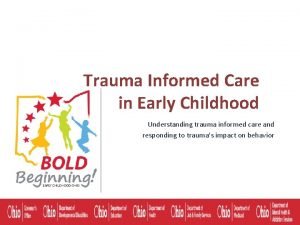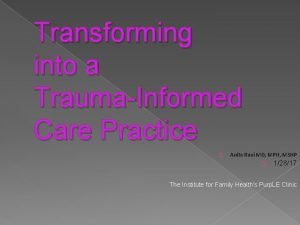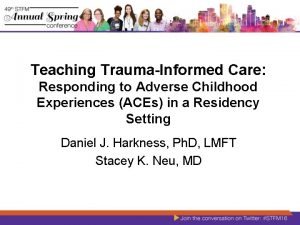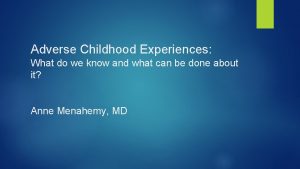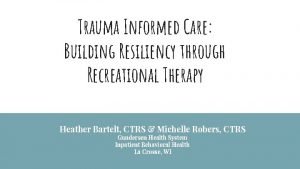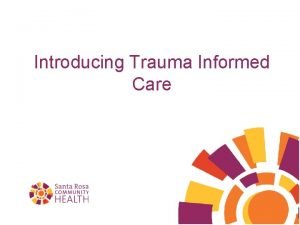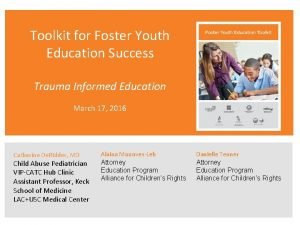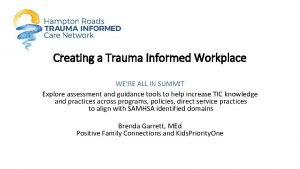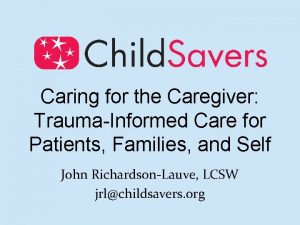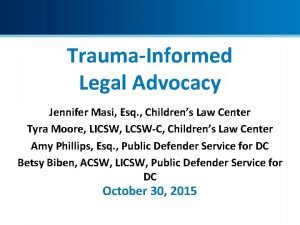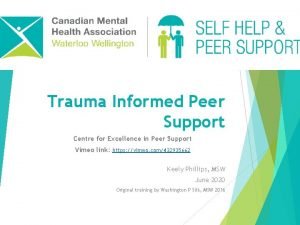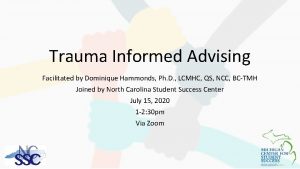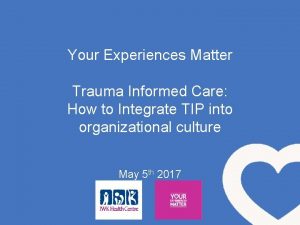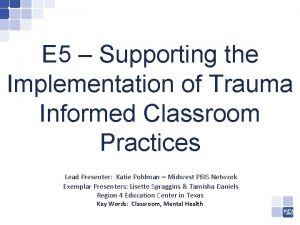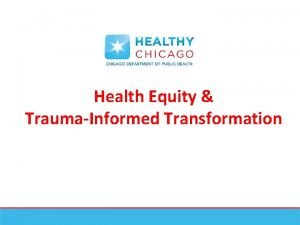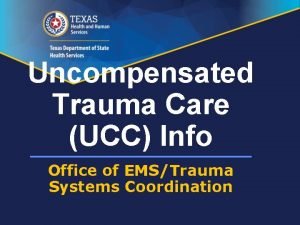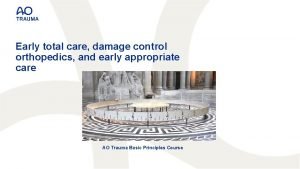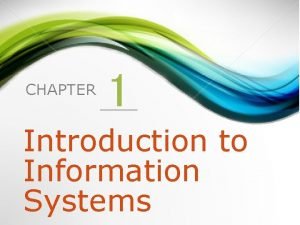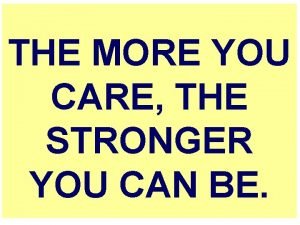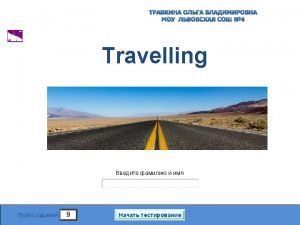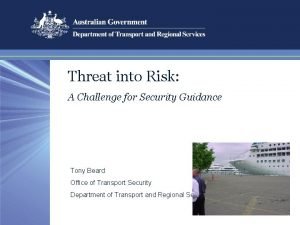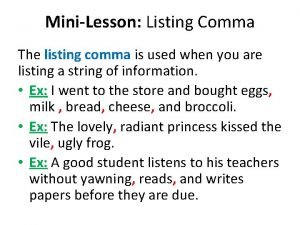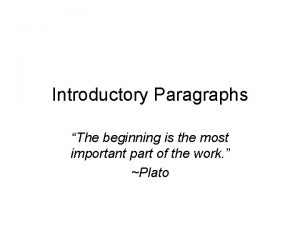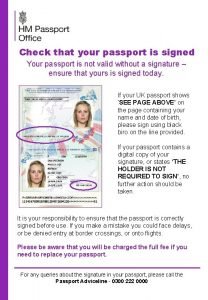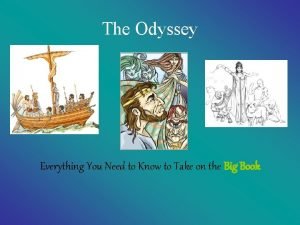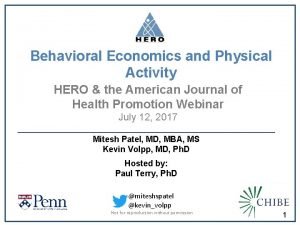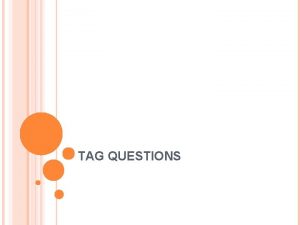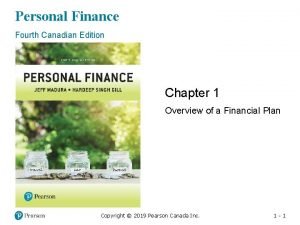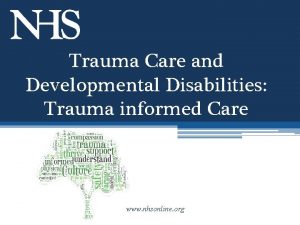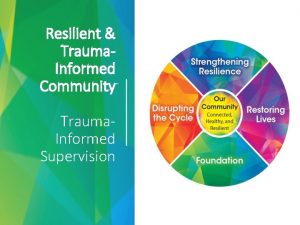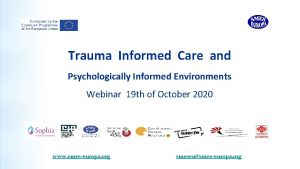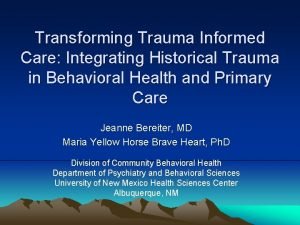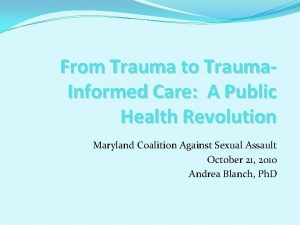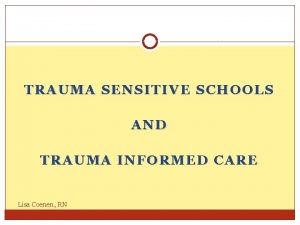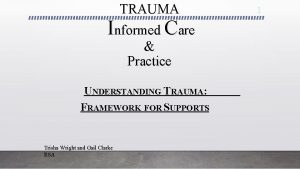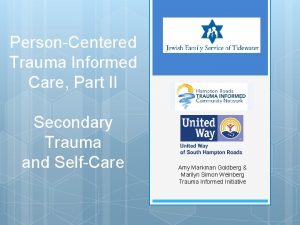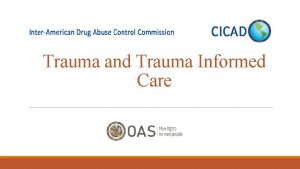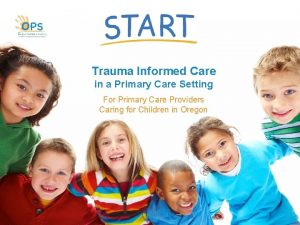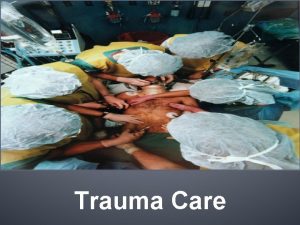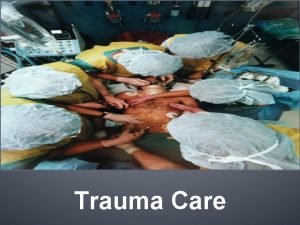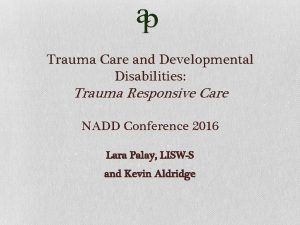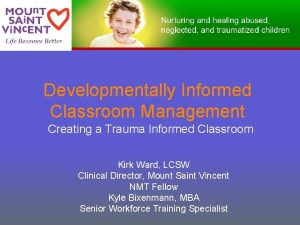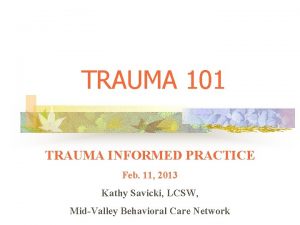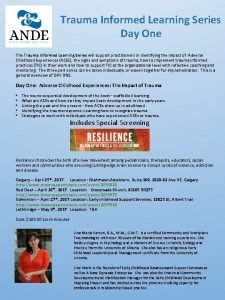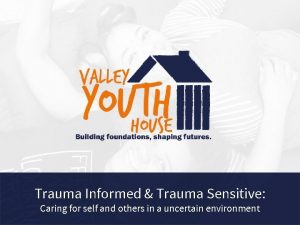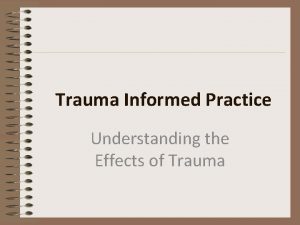What do you need informed care trauma informed















































- Slides: 47

What do you need informed care & trauma informed care in 2017? Diane K. Whitney MD, FRCPC, BCETS Assistant Professor NOSM, University of Toronto & Adjunct Professor Western University Community Based Practice Thunder Bay

Disclosure Slide – Slide 1 �Speaker: Diane K. Whitney MD, FRCPC, BCETS �Relationship with commercial interests: � Grant / Research Support: None � Speaker Bureau / Honoraria: Sunovion, Eli Lilly, Shire � Consulting Fee: None � Other: None

Disclosure Slide – Slide 2 �This program has received financial support from no organization. �This program has received in-kind support from in the form of no organization. �Potential for conflict(s) of interest: �Dr. Whitney will be speaking regarding medication used for PTSD treatment and where appropriate she will indicate if it is off-label use.

Learning Objectives: At the end of this presentation, participants will be able to: 1. Understand trauma informed care and how it is relevant to your practice setting. 2. Understand what is new in trauma treatment 3. Relevance of trauma diagnosis for responders & military veterans 4. Apply this to case vignettes – you referred!

Trauma Informed Care • What you need to know –Impact on Physical & Mental Health • ACE Study –www. acestudy. org • A Standard for Practice / Settings

Psychiatric Patients & Abuse �At least 70% of psychiatric patients have a history of some type of abuse �Sexual abuse is common-30 to 40% of women and 15% of men in general population �Verbal abuse particularly “put downs” have a particular negative impact �Trauma has negative impact on personal, social & emotional development & self image i. e. developmental trauma

ACE STUDY How stressful or traumatic experiences during childhood effect adult health

ACE Study -Introduction �Adverse Childhood Experiences (ACE) Study �To find how stressful or traumatic experiences during childhood affect adult health �Clear relationship between ACES Score with poor physical & mental health as well as premature death in adults �Linked to increased suicide attempts & depression �Relevant to North Western Ontario

ACE Study �Adverse Childhood Experiences (ACE) Study involving 17, 000 Kaiser Permanente patients from routine health surveys �To find how stressful or traumatic experiences during childhood affect adult health �Cumulative score related to adverse childhood event scale �Clear relationship between ACES Score with poor physical & mental health as well as premature death in adults

ACE SCORES � 63% of study participants had at least one category of childhood trauma & over 20% had 3 or more categories �ACE events tend to cluster together �Obesity used as shield against unwanted sexual attention or form of defense against physical attack �Many had been sexually &/or physically abused as children

ACE SCORES �See questions �You might be surprised by the scores of some of your patients �Caution about using scale as handout

ACE Study: Depression & Suicide �ACE score at least 7 increased suicide attempts: �Child/adolescent suicide attempts by 51 fold �Adult suicide attempts by 30 fold �Emotional abuse exhibited the strongest relationship to depressive symptoms in men & women �“Names do hurt”

Likelihood of Experiencing … The more categories of trauma experienced in childhood, the greater the likelihood of experiencing: � STD, Multiple Sexual Partners � COPD � Illicit Drug Use � Alcohol Abuse � Ischemic Heart Disease � Liver disease � Smoking � Obesity � Fetal Death

Trauma Informed Care What does it really mean? ?

Essentials of Trauma Informed Care �Health care provider who is: �Informed and sensitive to the impact of trauma �Adjusts how care is provided to accommodate to patient’s unique needs �Safety-the client feels safe and the environment & care provider is trustworthy �Client is given as much choice & flexibility as possible �Recognition that treatment by uninformed health care provider can be re-traumatizing

Asking About Trauma �Frequent occurrence in child, teen & adult life �Linked to depression, PTSD, addictions etc. �Impacts on adult life – functioning, relationships �Mental health systems focus on symptoms & typical syndromes i. e. depression, substance abuse rather than underlying issue(s) �Re-victimization is common (system tends to blame the victim)

Interactions with Health Care Providers �Distrust of authority figure �Fear on being abused �Fear of judgement �Need to feel “in control” �Disconnection from body �Conditioning to be passive �Feeling unworthy �Shame

Your Responsibilities �Asking the question(s) in a responsible manner �Containing the content & the emotion � Preventing “barfing on the carpet” � Acknowledging usual emotions-shame, sadness, anger & client’s strengths �Focusing on the impact of the trauma � Relationships � Emotions � Beliefs � Self Image, Self Perception �Spread discovery over time

Application in Your Environment �What are the defined guidelines / expectations for behaviour? � Safety, honesty, participation in treatment � Patient responsibility in recovery is key �Staff creating safety in treatment environment �Patients / family members not respecting safety i. e. threatening. What do you do? �What about patients who may disrupt safety environment for others?

Complex PTSD Concept of Judith Herman

Complex PTSD History of subjection to totalitarian control (repeated trauma) over a prolonged period. Usually relates to childhood repeated trauma. Resulting in alterations in the following: �Affect regulation modulation of anger, self- destructive, risk taking, suicidal preoccupation �Consciousness amnesia, transient dissociation �Self-perception ineffectiveness, guilt, shame Judith Herman 1992

Complex PTSD cont. �perception of the perpetrator adoption of distorted beliefs, idealization, preoccupation with hurting perpetrator �in relations with others inability to trust, revictimization, can sometimes victimize others �systems of meaning despair & hopelessness, loss of sustaining beliefs

Complex PTSD �Complex PTSD over course of childhood most often leads to PTSD 75%+ & other disorders i. e. attachment, use of dissociation to cope �Contrast to adults where most seriously traumatized have post traumatic reactions while only 18 -25% develop PTSD

Borderline Personality Reorganized into Complex PTSD Dysregulation in the following spheres: �Emotional � problem with anger, emotional instability �Interpersonal � unstable relationship, efforts to avoid loss �Behavioural � suicidal threats, self-damaging/impulsive behaviour �Cognitive � nonpsychotic thought dysregulation, depersonalization �Sense of Self � unstable self , self image, chronic emptiness

Why are Traumatized Patients in Crisis ? �Increase in trauma symptoms due to: � Changes in patient’s external environment � Loss of supportive relationships or important external supports � Current traumatic events or reminders of past traumatic event i. e. anniversaries � Conflict / trauma in current relationships �Self harm & suicide attempts �Hospitalization is not “benign” for previously abused women, often re-traumatizing � So patients seek outpatient care

Present versus Past Focus • What should treatment focus on? • Risks & Benefits of each focus

Treatment Controversy: Past versus Present �The Choice to focus on past traumatic events or focus on the present & the impact of trauma in current life �“Present Centred Therapy” �Seeking evidence based recommendations � Many patients drop out of exposure based therapy

Past Focus �Past focus includes details of past events i. e. exposure, cognitive processing, EMDR �Risk for destabilizing patient �Naïve therapists who move in early to address past experiences before stabilization �Even with experienced therapist decompensation can occur �Can require significant resources & time –often 2 -5 years, sometimes 10 years

Present Focus �Present-centred perspective focuses on altering present maladaptive relationship patterns, providing psychoeducation on client’s current life, teaching use of problem-solving strategies �Minimize maladaptive coping strategies such as substance abuse, poor partner choices etc. �Focus on positive coping strategies �Group interventions for education & coping

Implications for Primary Care �Focus should be on understanding trauma & its consequences on current life �Function & recovery should be the focus �Be cautious on over emphasizing recall & reprocessing past events �Be cautious on “putting patients off work” to deal with trauma –ongoing recovery

Treatment Model: Complex PTSD Late Middle Consolidation & Further Growth Exploration of Traumatic Events Functioning Expression of Emotions Improve Relationships Self Care Symptom Control Acknowledgement of Trauma Early

Self Care �Self destructive & dysfunctional behaviours need to be reframed � attempt at coping, self protective & healing efforts �Self Soothing & Relaxation Techniques to manage hyperarousal & intrusive symptoms � Mindfulness � Distress Tolerance Skills (Linehan) � distract, self soothe with senses, improve the moment

Symptom Control �Assessment/Analysis completed first to “understand” symptom(s) i. e. self harm, dissociation �Grounding Techniques & Strategies � breathing, awareness of environment, coping self talk, safe place imagery, carry special object �Dealing with Flashbacks � education, avoid triggers, processing & integrating afterward � Creation of list of alternative, distracting & soothing behaviour

Acknowledgement �Central role of early trauma in symptoms and interpersonal experiences � current behaviour & difficulties seen as adaptive responses to overwhelming events �Flawed assumptions about self, world & others � CBT interventions i. e. use of thought record �Assumption of inappropriate responsibility for abuse but need to assume responsibility for recovery � Importance of normalizing messages

Medications for PTSD • Antidepressants & anti-anxiety medication • Sleep medication –nabilone, prazosin etc. • Medical Marijuana –controversial, use with other medication

Antidepressants �Meta-analysis (Lee 2016) revealed benefit over time for sertraline, venlafaxine & nefazodone (no longer on the market) � Improvements with paroxetine & fluoxetine were small � Bupropion, citalopram, divalproex, mirtazapine, topiramate failed to differentiate from placebo � Ariprazole, divalproex, olanzapine failed to differentiate from placebo � Not all SSRIs & Sn. RIs alike, trials should be 8 weeks �Medications act largely by blunting expression of symptoms of PTSD rather than acting on underlying neurobiological mechanisms

Sleep / Hyperarousal �Avoid / minimize benzodiazepines! � High dose benzos often an indicator of PTSD �Imovane / Zoplicone � Issue of dependence / over reliance �Prazosin � Initially used by US military in Afghanistan War � Effective for traumatic nightmares, awakenings & hyperarousal � Limitation is base line BP �Nabilone / Cesamet � Use began by Dr. George Fraser � Nightmares, awakenings. Some controversy.

Medical Marijuana & PTSD �The actual scientific evidence for medical marijuana is limited to severe nerve pain. �The evidence for anxiety is mixed –low dose THC may reduce anxiety and high dose may cause or worsen anxiety symptoms. �For PTSD, medical marijuana in veterans has been associated with worse violence, alcohol & drug use and PTSD several. �Overall there is no scientific evidence for medical marijuana in anxiety or PTSD.

st 1 Responders & PTSD

Bill 163 –PTSD in 1 st Responders �Supporting Ontario’s First Responders Act (PTSD) 2016. � All Firefighters, Fire Investigators, Police Officers, Mbrs of Emergency Response Team, Paramedics, Emergency medical attendants, Ambulance Service Managers, Workers in Correctional Institution, Workers involved in dispatch �Amended WSIA to create a statutory presumption that PTSD diagnosed in first responders is work-related. Onus to prove otherwise rests with employer �Requires PTSD diagnosis by psychiatrist or psychologist �Employers to create plan(s) for prevention / management in the workplace

Key Work Environments �Most notable are emergency services, military, acute medical services, bank officers, train drivers & other accident prone industries such as mining, agriculture & fishing �Recently EMS/paramedics and police officers, fire fighters & health care professionals have been identified as high risk for PTSD & suicide –challenge for WSIB �Studies report the PTSD rate for EMS to be 20% which is double the general population

Physical Health & Police Officers �At risk for high blood pressure, insomnia, increased levels of stress hormone, heart problems & PTSD � Officers over 40 yrs had higher 10 year coronary event rate � Higher cholesterol levels particularly in female officers � Higher than average pulse rates & diastolic blood pressure – activated sympathetic nervous system (fight / flight) �Higher cortisol levels in am & remained high during day �Chronic stress often related to administrative issues

Mental Health & Police Officers �Suicidal thoughts reported in police officers � Females working day shift more likely to report depression & suicidal thoughts � Males working afternoon or night shift reported depression �Ontario Ombudsman identified that 23 OPP police officers committed suicide between 1989 to 2012 �In Canada in 2013 37 first responders & 9 military members died by suicide �More police officers commit suicide than killed in line of duty!

Resiliency � Defined as the ability to maintain a state of normal equilibrium in the face of extremely unfavourable circumstances �Internal Characteristics: Self-esteem, trust, resourcefulness, self-efficacy, internal locus of control, secure attachments, sense of humour, mastery, optimism � Interpersonal abilities including social skills, problem solving, impulse control � �External Factors: Safety, religious affiliation, strong role models, � Emotional sustenance –extent to which other provide the individual with understanding, sense of belong & positive self-regard � “Espirit de corp” �

Resiliency – 5 Cs �Control & Confidence �Commitment �What drew me to this work in the first place? �Caring Connections & Good “Holding Environment” �Calmness �Yoga, Meditation, Mindfulness �Care for Self

Resources Complex PTSD (Australian) website - www. outofthestorm Books for Patients: Life After Trauma 2 nd Edition by Dena Rosenthal & Mary Beth Williams. Guildford Press 2010. Cost $20 Amazon. The PTSD Workbook-Simple, Effective Techniques for Overcoming Traumatic Stress Symtpoms 3 rd edition by Mary Beth Williams & Soili Poijula. Guildford Press 2016. Cost $30 Amazon. Complex PTSD From Surviving to Thriving: A guide & map for recovery from childhood trauma by Peter Walker. Azure Coyote Press. 2013. Cost $30 Amazon.

Questions / Discussion
 4 r's trauma informed care
4 r's trauma informed care Lgbtq trauma informed care
Lgbtq trauma informed care 4 r's trauma informed care
4 r's trauma informed care 4 r's trauma informed care
4 r's trauma informed care 4 r's trauma informed care
4 r's trauma informed care Www.dfps.state.tx.us/training/trauma informed care/
Www.dfps.state.tx.us/training/trauma informed care/ Sensory modulation
Sensory modulation Trauma informed practice
Trauma informed practice Trauma-informed care activities for staff
Trauma-informed care activities for staff Trauma informed care for foster youth
Trauma informed care for foster youth Trauma-informed workplace checklist
Trauma-informed workplace checklist Trauma-informed questions for clients
Trauma-informed questions for clients Trauma informed legal advocacy
Trauma informed legal advocacy Trauma informed peer support
Trauma informed peer support Trauma informed advising
Trauma informed advising Trauma informed parenting discipline
Trauma informed parenting discipline Trauma informed practice
Trauma informed practice Trauma infromed
Trauma infromed Trauma informed practice
Trauma informed practice Primary, secondary, tertiary care
Primary, secondary, tertiary care Uncompensated trauma care application texas
Uncompensated trauma care application texas Total care orthopedics
Total care orthopedics Wish you all the strength
Wish you all the strength Punctuating split speech
Punctuating split speech Informed user of information systems
Informed user of information systems Standardasation
Standardasation It can be quite busy here during the tourist
It can be quite busy here during the tourist 5 hobbies you need
5 hobbies you need You only need to be lucky once
You only need to be lucky once Attention is all you need google
Attention is all you need google Example of why oxford comma is important
Example of why oxford comma is important Love is not all it is not meat nor drink
Love is not all it is not meat nor drink Coherence examples
Coherence examples Fsa essay
Fsa essay How do you sign your new passport
How do you sign your new passport How to do an argumentative essay introduction
How to do an argumentative essay introduction Everything you need to know about the odyssey
Everything you need to know about the odyssey The drawing shows samir riding his mountain bike
The drawing shows samir riding his mountain bike If the acceleration lane is short, you will need
If the acceleration lane is short, you will need Choose the corret answer
Choose the corret answer Let's be a good friend
Let's be a good friend You need to make at least 150 sandwiches for a picnic
You need to make at least 150 sandwiches for a picnic Much do you need health
Much do you need health You have need of endurance
You have need of endurance I need you lord jesus
I need you lord jesus All i need is the air that i breathe and to love you abba
All i need is the air that i breathe and to love you abba This or that tag
This or that tag Money is all you need
Money is all you need
